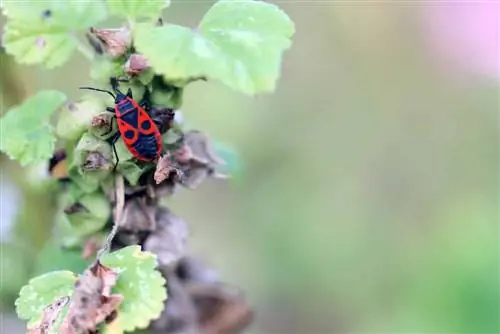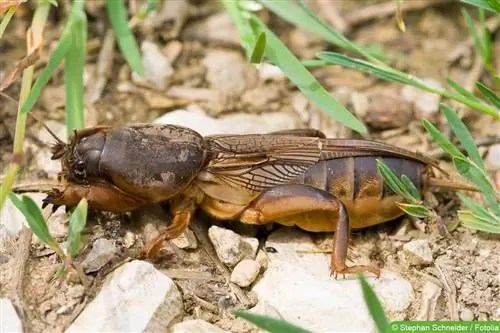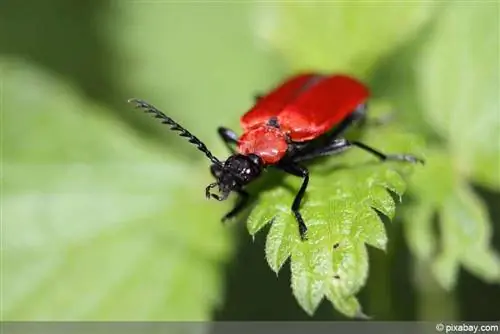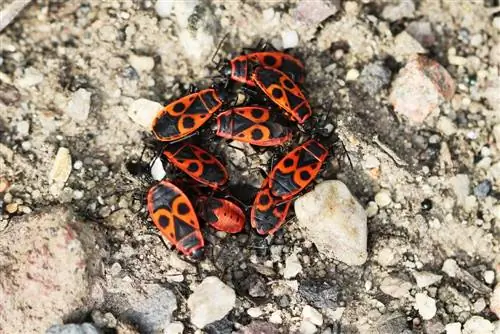- Author admin [email protected].
- Public 2023-12-17 03:39.
- Last modified 2025-01-24 12:45.
Fire bugs are easy to recognize because of their striking coloring and appear mainly in summer. The insects have a red shell that is covered with black dots, triangles and crescents. Fire bugs are social animals and always appear in larger groups, the size of which can quickly grow to several hundred individuals in good weather conditions. Although the patterned insects are not harmful to native plants or people, they can spread extremely and become a real pest in the garden.
Characteristics
As soon as it gets warm again at the end of winter in February and March and the sun gains strength, the fire bugs come crawling out of their winter quarters. The busy insects crawl up tree trunks, house walls and stone walls to reach the places where it quickly becomes warm. In the spring months of April and May the fire bugs reproduce extremely quickly and can form extremely large groups:
- Easy to recognize by their red and black shell
- Black dots, triangles and crescent-shaped symbols are drawn on a red background
- There is a black trapeze on a red background around the neck
- Head, six legs and two antennae are also black
- Coloring and symbols can vary greatly
- Usually approx. 1 cm long
- Some specimens can fly depending on the species
- Love warm and dry conditions and places
- Don't crush, but release extremely stinky secretion
Danger
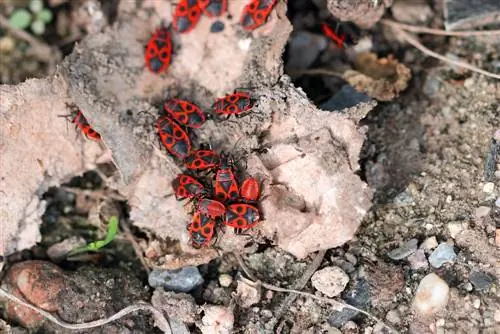
The fire bugs themselves pose no danger. The insects do not transmit any harmful diseases and do not harm he althy plants because they feed primarily on plant waste. For this reason, fire bugs do not necessarily have to be fought. So far there are no known cases in which the appearance of the insects has caused plants to wither or even die:
- Do not cause any harm to living plants or humans
- Fighting is not really necessary
- However, fire bugs are annoying, perceived as annoying and extremely unpleasant
- Can also penetrate houses and apartments, but rarely
- To avoid odor nuisance, put it back outdoors with a shovel and broom
Food Basics
Fire bugs feed mainly on plant waste in the garden, but occasionally eat animal food. The insects are not particularly picky and have a large appetite, especially if the group has become very large:
- They feed by sucking, can only eat liquid food
- Prefer fallen leaves and fruit
- Every now and then small insects and their eggs are on the menu
- Love mallow plants, especially linden trees and hibiscus bushes
- Favor the fruit heads/nuts of linden trees, mallows and horse chestnuts
Tip:
If an infestation of fire bugs occurs again and again, it is better not to plant mallow plants in the garden so as not to attract the fire bugs more.
Natural control
Fire bugs prefer warmth and dryness, so hosing them down with cold water is a natural, easy and effective way to combat these annoying insects. However, caution is advised here as sensitive plants can suffer from the water treatment. In this case, washing with a gentle soap solution is recommended:
- Hose off fire bugs with a powerful jet from the garden hose
- Perform the procedure repeatedly to sustainably prevent the spread
- As an alternative, fill a standard spray bottle with water and a splash of soapy water
- Dish detergent, hair shampoo and liquid soap are suitable as a basis for the soapy water
- Spray fire bugs, their surroundings and also the infected plants
- The spray mist causes the vermin to die within a few minutes
- Spraying is gentler and hits plants much softer than a hard jet of water
- Ideally use rainwater and organic soapy water
Tip:
The fine spray from the spray bottle also reaches hidden places and places, and the soapy water also helps against aphids and mildew. When used, useful animals, your own he alth and the plants are protected.
Prevention
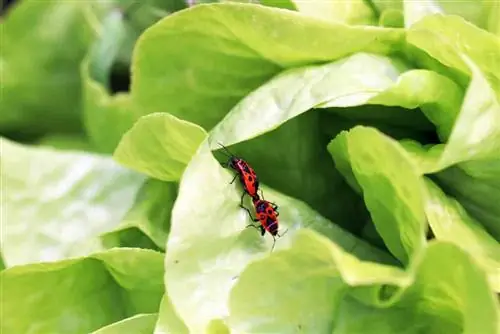
The fire bugs can be effectively combated in advance if their preferred habitats are periodically cleaned with water. In this way, the necessary food sources for the fire bug are removed and the pest moves to another place on its own:
- Wash down trees, house walls and stone walls regularly with a garden hose
- Remove plant waste promptly
- Don't store old leaves in the garden, it offers an ideal place for overwintering
- Always check the pile when raking leaves
- Also likes to hibernate in hollow tree trunks and under broken pieces of bark
- Also likes compost heap, always cover it well to prevent infestation
- Remove fruits of the mallow family before they are ripe
Implement
During the cold season, fire bugs hibernate. In order to survive the winter unscathed, the insects form a kind of clump. These can be quickly located in the garden and removed if you have a sharper eye for them:
- Look for fire bug clumps in the spring
- These are mainly found under old leaves and at the base of the host plants
- Sweep up with hand brush and dustpan and collect in the bucket
- A lockable container is ideal for transport
- Release fire bugs far from the garden, somewhere in the wild
- How to remove the largest number of pests before spreading again
Predators
The fire bugs have no predators in nature as they secrete a smelly secretion when they are eaten. With similarly sized enemies, this body secretion has a temporary paralyzing effect when contact occurs. For much larger predators and humans, the secretion only has harmless effects, apart from the extremely unpleasant stench. Young animals initially eat fire bugs out of ignorance, but after the first consumption the insects are avoided:
- In case of danger, a gland intended for defense releases a foul-smelling secretion
- Smelly secretion drives away potential attackers quite quickly
- Secretion makes the fire bugs completely inedible, but is not poisonous
- Red-black signal color of the tank promotes the deterrent effect
- Some species can sting, although no such cases have been reported in humans
Tip:
The foul smell is particularly intense when the fire bug is crushed, so it is better to remove the pest without causing any damage.
Chemical agents
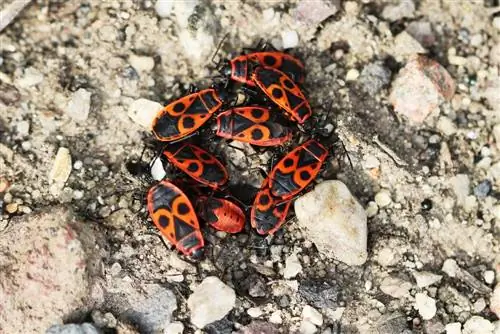
Specialist retailers offer many chemical insecticides that can be used to quickly combat fire bugs. However, these products are extremely harmful to both nature and humans and should only be used with caution:
- Use chemical insecticides only in an absolute emergency
- Although they kill fire bugs quickly, they also kill useful insects, for example bees, bumblebees, etc.
- Also harmful effects on humans, especially small children
Conclusion
Fire bugs are not dangerous insects, but they can be very annoying as they usually occur in large numbers in large groups. The black and red signal color of the pest is an indication of an extremely smelly secretion that comes out when there is a threat of danger or when it is eaten. Therefore, the fire bugs should not be crushed to avoid this unpleasant odor. If the annoying insects also invade living spaces, they must be picked up and removed. In order to permanently remove the fire bugs from the garden, the clumps that they form for overwintering must be relocated in early spring. In addition, the animals should be deprived of their food source so that they can look for another location. This includes old leaves and fallen fruits, which are sucked out by the fire bugs. For quick control, spraying with a garden hose and spraying with soapy water can help.

